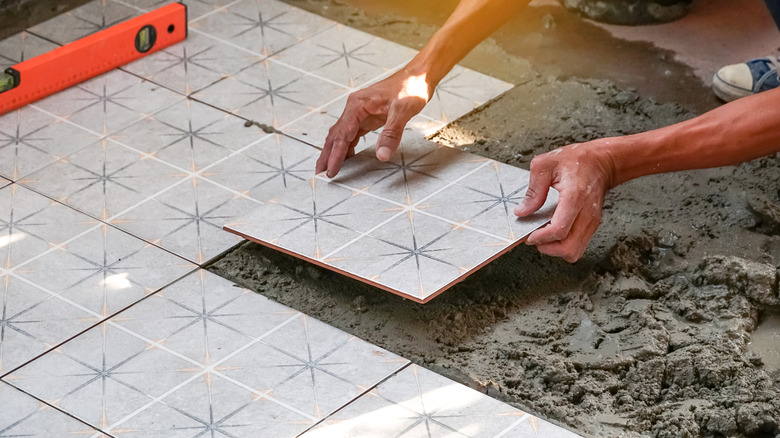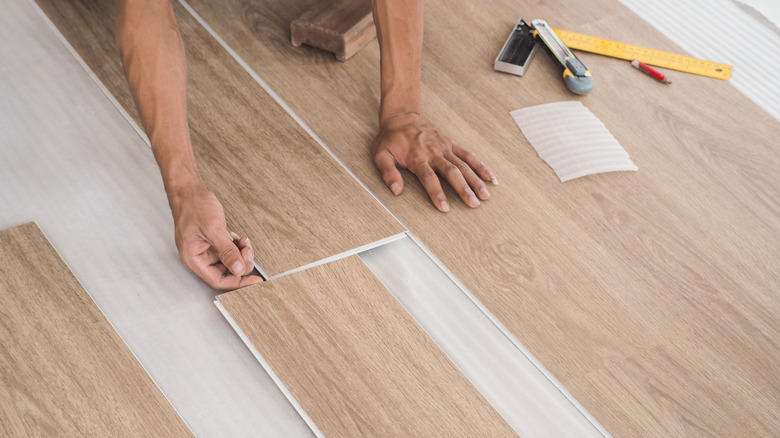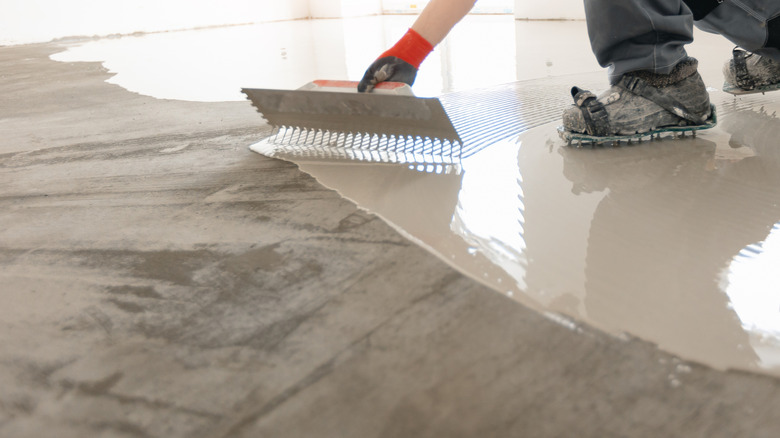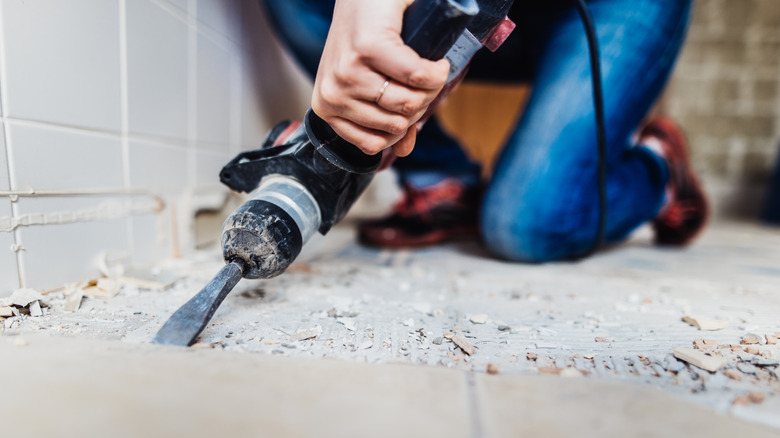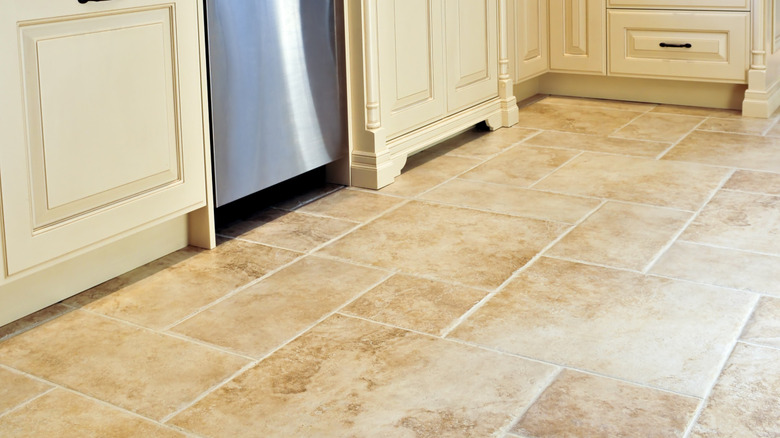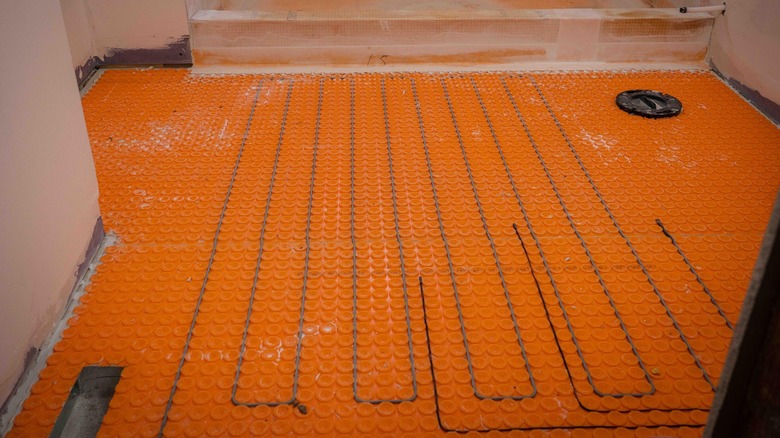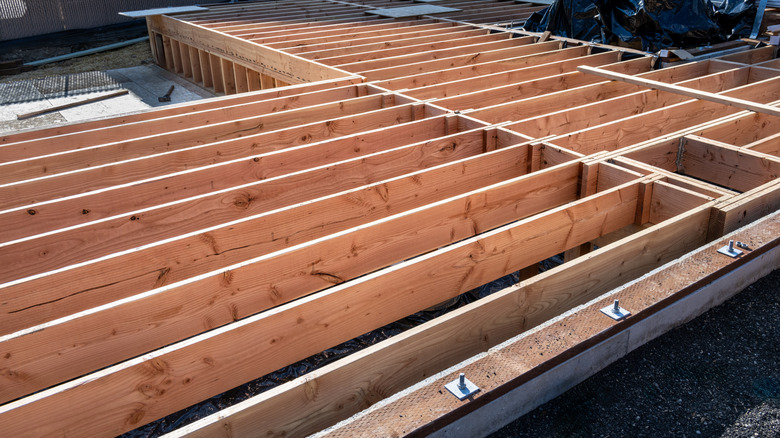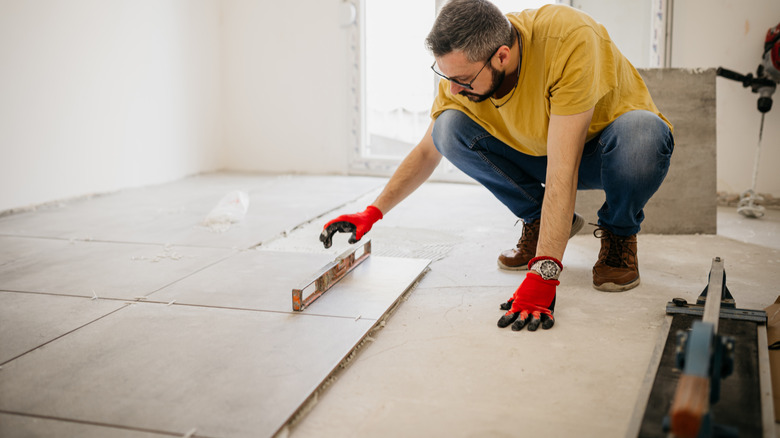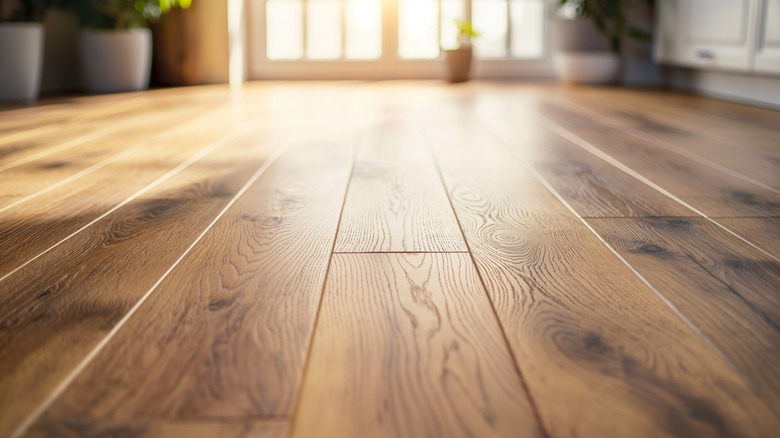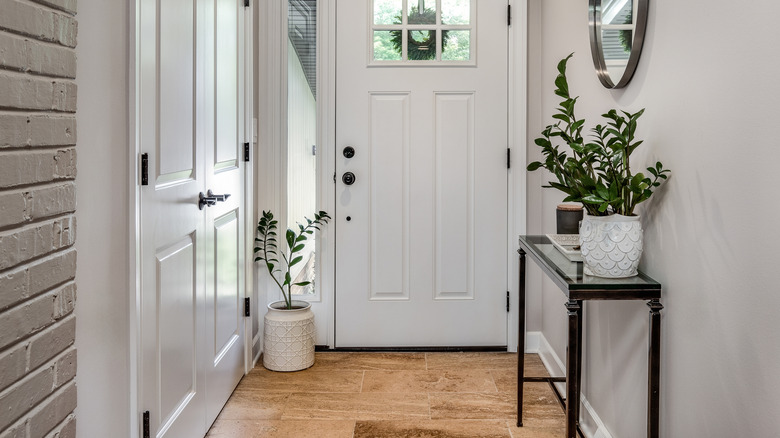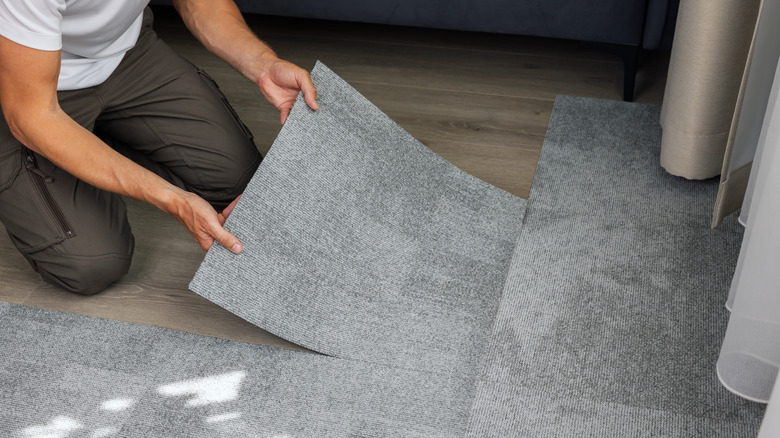Flooring Tips That HGTV's Mike Holmes Swears By
Getting your flooring done right is essential to the success of your home's remodel — it's literally the foundation for each room! And no one knows this better than Mike Holmes. The longtime HGTV host and contractor from Canada is famous for his no-nonsense attitude towards home projects and his ability to fix up what others in his field have ruined, even if it was a DIY project. "Nothing is ever simple in any renovation, and even cosmetic repairs like replacing flooring can go wrong if it's not done well," he told HomefulTV, per YouTube.
To avoid appearing on an episode or two of "Holmes Family Rescue," Mike has plenty of resources out there to help you and your team make the correct flooring choices the first time — no need for awkward (and expensive) re-dos to happen on national television. Whether you are stuck picking the best flooring for your kitchen, wonder if you can actually afford in-floor heating, or think LVP isn't all it's cracked up to be, these are the flooring tips that HGTV's Mike Holmes swears by.
There actually IS a correct flooring choice for the basement
While the best use of a finished basement might be up for debate, the best flooring choice for the space isn't — at least according to Mike Holmes. "I don't think people realize that tiles should be the number one product you put in your basement," he said in a Facebook video. "Wood, linoleum, carpet — these are a lot of things people put in the basement. You're gonna be taking that out."
His reasoning behind this choice is actually pretty simple. Tiles are quite easy to keep clean and dry — so you don't have to worry about standing water or flooding. Additionally, tiles reduce the chance of mold growth, as moisture from the concrete won't get trapped between the foundation and materials that hold onto dampness like wood or carpeting. Holmes also notes that tile is less susceptible to the wear and tear of foot traffic, allowing it to last longer, especially if you use your basement a lot. Pet mess isn't as much of an issue, either. You can mop anything up with ease. Plus, when compared to carpet or wood, tiles tend to be much easier to clean, so eating and drinking in the basement is a lot safer. Plus, if you live in a colder climate, you can add in-floor heating. It works like a dream and makes sure that even with tile, you never feel chilly underfoot.
If you choose LVP, keep extra planks on hand
Luxury vinyl planking, or LVP, is a favorite flooring choice among many HGTV stars, including Mike Holmes. It's known to be more durable and less expensive to install than its hardwood counterparts. However, Holmes has a quick tip for anyone considering the option to make the most of it. "Vinyl is a terrific choice if you're looking for a less expensive floor. It's also easy to put together, so if you're searching for a DIY project, you can save money and time," he wrote on Facebook. "Because vinyl is not as durable as other materials, I recommend adding felt bumpers to your furniture feet and keeping some extra planks to ensure a perfect match in the event of damage."
You don't have to break your budget over-ordering, but having a dozen or so extra planks on hand can save you a real headache. Simply store them in a dry, temperature-controlled space like a guest bedroom closet, and pull them out only when needed. This also saves you the drama of needing to order replacement planks (which can be expensive if you aren't buying much — flooring prices tend to drop the more you buy, so it makes more sense to over-order by just a little at the beginning.) Plus, should your specific color be discontinued, you won't be stuck with the dilemma of mismatched flooring.
Using a layer of self-leveling cement can ensure your subfloor is flat
No matter what flooring type you choose, if your subfloor isn't level, you aren't going to be happy with the results. Subflooring is the layer above the beams that supports the floor and ensures a flat surface for the final flooring material. It helps to prevent sagging and maintain floor strength. Holmes thinks concrete is the best subfloor material. This is especially true if you are already having issues with the floor's slant. "Self-leveling cement is a good alternative for leveling without having to fix the entire structure of the floor. Using a self-leveling floor compound will help ensure that the concrete is completely flat before you lay the tiles or hardwood," he shared on his website, Make It Right.
This step isn't a quick fix, but it will set you up for plenty of success later on. "Adding a layer of self-leveling compound to your concrete adds an extra day to your flooring job," he said. "But it reduces the chances of problems with your flooring later." As with most home improvement tasks, more time and effort at the beginning will save you from a lot of difficulty later on.
Pull up old tile before installing a new layer
If anyone has ever told you that you can just tile over your kitchen or bathroom without any issues, Holmes insists that these people are just wrong. "Some homeowners and contractors think you can lay your new tile directly over your existing tile to save some time," he said in an Instagram Reel. "Why do I hate this? Well, for one thing, you're just asking for your new tile and grout to crack — so that brand new floor isn't going to keep its look for very long."
This is because the weight of the new tile on top of the old tile is just too much. There isn't any flexibility or breathing room in the design, so the slightest amount of pressure on the wrong spot is just asking for trouble. Tearing up the old tile is one of his best tips for a seamless home renovation. Not only is this because the new tile won't crack, but you also give yourself a chance to suss out any hidden problems. "The bigger issue is that without tearing up the existing floor, you can't properly judge the state of the underlay," he continued. "Tear up the old, assess the state of the subfloor, and fix what needs fixing. A bathroom provides the right conditions for mold spores (moisture, air, and a source of food), and your tile might be covering up a hidden issue that you'll want to fix."
Tile is the best choice for kitchen floors
The kitchen is one of the busiest rooms in the house, so you need a flooring choice that can withstand high traffic. It should also be relatively waterproof and easy to clean, as it's not just a matter of if spills will happen in the kitchen, but when. For Mike Holmes, there is one clear winner: tile. "Ceramic and porcelain tiles are my recommendation for kitchen floors," he shared on Make It Right. "They are durable, attractive, easy to clean, and available in a large variety of patterns and finishes."
The best thing about tile is that it's very easy to show your personality through the pattern you choose. You can select a large-format tile if you like something visually simple or a colorful tile in a pattern like herringbone if you want to go for something a bit more stimulating. What is most important is that you install and seal the tile's grout properly so that it doesn't chip or discolor through high use.
Adding heated flooring to your bathroom is great for chilly winters
Sometimes things you might consider luxuries are actually necessities, especially if you live in a colder climate. Such is the case for heated floors, especially if you are renovating the bathroom in your forever home. "I think heated floors are a great addition to any bathroom renovation. They can provide continuous warmth and comfort to the space, which can be a nice touch as we tend to feel the cold more as we age," Holmes wrote on Make It Right. Nothing makes an early morning more challenging than a freezing cold floor. For a small investment up front, you'll be more comfortable for years to come. The Holmes family tends to work with Schluter Systems to install in-floor heating. The average cost for something like this is around $30 per square foot.
If you have in-flooring heating, you need to pair it with a suitable flooring choice as well. "The best flooring option for in-floor heating is typically porcelain or ceramic tile. These tiles are durable, have excellent heat conductivity, and stay warm longer, offering better energy efficiency than other materials," Holmes continued. Plus, tile works great in the bathroom because it's easier to waterproof a tile floor.
Adding blocks to your floor joists can stop squeaking
Squeaking floors are annoying — but sometimes the issue is way bigger than just a single loose floorboard. In fact, if your floor seems to creak all over, the problem is incorrect floor joist installation. "It could be that they've been spaced too far apart, or they haven't been properly blocked," Holmes wrote for Make It Right. "Blocking between your joists adds stiffness, preventing them from moving, which means fewer squeaks in your finished floor." He went on to say that if you want to fix it yourself, it's only possible if you can easily access the joining from underneath. This is more common in unfinished basements and in homes with crawl spaces. Once you are down there, you can add more blocks, "assuming there aren't any ducts or wiring in the way," he continued.
For more extreme cases, Holmes advised speaking with a structural engineer for the safest results. This would be if the floor is not only squeaking, but also sagging — indicating that the existing joists are close to failing. To fix this, the engineer would likely recommend sister joists, which are healthy pieces of wood attached to the broken ones. However, Holmes never recommends doing this yourself as doing it incorrectly leads to an unsafe home.
Waterproofing your bathroom floors will save you plenty of headaches
The bathroom is a wet place by its very nature, so it's important for the flooring you choose to be up for the challenge. If you are DIY-ing your bathroom renovation, Holmes says that paying close attention to the waterproofing step will land your final product up there with the pros. "Waterproofing your floor is an important step in making your bathroom watertight. Assuming your subfloor is in good shape and level, your next step is waterproofing," he wrote on Instagram. "Use a layer of unmodified thin-set mortar on your substrate, then add an uncoupling membrane, like Schluter Ditra and Ditra-XL."
He goes on to share that the next step is to actually add a second layer of thin-set mortar over the top of this membrane. Some might tell you to use a modified thin-set mortar, but Holmes recommends staying far away from these. This is because they need plenty of time exposed to the air to cure correctly. If you place your tile right over the top of them (as you are supposed to) then "the tile and waterproof membrane don't breathe," he said. "That means no airflow, and it would take forever to dry." Instead, stick to unmodified and things will cure as they are supposed to — and water won't seep down into your flooring later on, ruining all your hard work.
The right floor color can bring a space together
When selecting the flooring for your home, be it carpet, tile, hardwood, or even LVP, you need to think about its color and how it can impact the rest of the space. "Hardscapes are everything, and [the] hardscape is your flooring. [You've] got to pick the right color," Holmes told his viewers on YouTube. This is because lighter floors are more bright and airy, while darker tones can set a more serious mood for your home.
In Holmes's case, he had already selected the paint color for the walls of his project, and thus wanted the flooring to match. "I wanted to keep it very warm. I didn't want it to stand out. I really wanted it to complement the colors," he continued during the home's walkthrough, pointing out the different features of the space. "I wanted to pick up the whites and the browns ... from this area into the stairs. And you can see that all those colors are now coordinating in; it feels comfortable." When selecting your flooring color, consider what is most important to you. If it's budget, you might go for the cheapest option, no matter the color. But, if it's style and ambiance, you should think about balancing lights and darks, as well as matching tones with the paint colors and furniture in your room.
Never install hardwood by the front door
Holmes thinks it's up to you to choose the best flooring for your living room, unless you have a home that's a more open concept. If you have a front door that opens directly into your living room, you shouldn't have hardwood there. Technically, the same goes for anyone with an entry hall, too — no hardwood near exterior entry points. "Never put hardwood floors right at the front door, as you can ruin the wood when you bring in moisture from outside," Holmes told HGTV Canada, now the Home Network. It makes sense that hardwood should never be installed in this area, as the snow, mud, and other elements will have a huge impact on the area just beside the door — whether you wipe your feet off or not.
Wood is sensitive to moisture and can rot or warp if there is too much of it around. Instead, for the flooring adjacent to the front, back, or even side door, you need to reach for something a bit more waterproof. Ceramic tiling or even LVP are both great choices because they are easy to keep dry and clean. While laminate flooring can have some water-related issues, it is typically easier to fix than warped or rotting wood.
Carpet is the best choice if you're on a budget
Redoing your floors doesn't have to be as expensive as you think. "If you do have a smaller budget, carpet is the cheaper choice," Holmes said, per HGTV Canada, now the Home Network. He would choose it over wood or tile when working on a tight budget. Carpet is also plush, soft underfoot, and comes in many different patterns and colors.
For the messier folks, if you are worried about committing to re-carpeting a room if you spill something, or just living with the spills, you don't have to be. Carpet tiles are the answer, especially for rooms your children will spend lots of time in. "Consider hypo-allergenic carpeting for your kid's playroom," Holmes continued. "And although carpeting isn't typically spill-friendly, there are carpet tiles that come in all sorts of designs and colors, so if a spill does happen, the carpet tile can be removed and replaced." Just like you might slot in a new plank of LVP, you can easily swap the carpet tile — so you can live mess-free.

